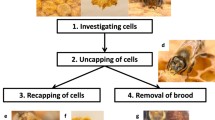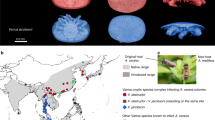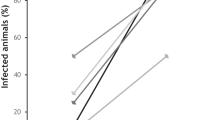Abstract
The queens of many eusocial insect species are polyandrous. The evolution of polyandry from ancestral monoandry is intriguing because polyandry undermines the kin-selected benefits of high intracolonial relatedness that are understood to have been central to the evolution of eusociality. An accumulating body of evidence suggests that polyandry evolved from monoandry in part because genetically diverse colonies better resist infection by pathogens. However, a core assumption of the “parasite–pathogen hypothesis”, that there is variation in virulence among strains of pathogens, remains largely untested in vivo. Here, we demonstrate variation in virulence among isolates of Ascosphaera apis, the causative organism of chalkbrood disease in its honey bee (Apis mellifera) host. More importantly, we show a pathogen–host genotypic interaction for resistance and pathogenicity. Our findings therefore support the parasite-parasite hypothesis as a factor in the evolution of polyandry among eusocial insects.

Similar content being viewed by others
References
Anderson D, Giacon H, Gibson N (1997) Detection and thermal destruction of the chalkbrood fungus (Ascosphaera apis) in honey. J Apic Res 36:163–168
Aronstein K, Murray KD (2010) Chalkbrood disease in honey bees. J Invert Path 103:S20–S29
Baer B, Schmid-Hempel P (1999) Experimental variation in polyandry affects parasite loads and fitness in a bumble-bee. Nature 397:151–154
Baer B, Schmid-Hempel P (2003) Bumblebee workers from different sire groups vary in susceptibility to parasite infection. Ecol Lett 6:106–110
Boomsma JJ, Beekman M, Cornwallis CK, Griffin AS, Holman L, Hughes WOH, Keller L, Oldroyd BP, Ratnieks FLW (2011) Only full-sibling families evolved eusociality. Nature 471:E4–E5
Bourgeois AL, Rinderer TE, Sylvester HA, Holloway B, Oldroyd BP (2012) Patterns of A. mellifera infestation by Nosema ceranae support the parasite hypothesis for the evolution of extreme polyandry in eusocial insects. Apidologie 43:539–548
Brown MJF, Schmid-Hempel P (2003) The evolution of female multiple mating in social hymenoptera. Evolution 57:2067–2081
Burnett J (2003) Fungal populations and species. Oxford University Press, New York
Chorbinski P (2003) Susceptibility of Ascosphaera apis strains to antifungal preparations. Medyeyna Weterynaryjna 59:1137–1139
Crozier RH, Fjerdingstad EJ (2001) Polyandry in social hymenoptera—disunity in diversity? Ann Zool Fenn 38:267–285
Crozier RH, Page RE (1985) On being the right size: male contributions and multiple mating in the social hymenoptera. Behav Ecol Sociobiol 18:105–115
Ebert D, Hamilton WD (1996) Sex against virulence: the coevolution of parasitic diseases. Trends Ecol Evol 11:79–82
Gilliam M, Taber S, Lorenz BJ, Prest DB (1988) Factors affecting development of chalkbrood disease in colonies of honey bees, Apis mellifera, fed pollen contaminated with Ascosphaera apis. J Invert Path 52:314–325
Glinski Z, Chmielewski M (1982) Studies on the pathogenicity of Ascosphaera apis for honeybee larvae. II Relationships between biochemical type and virulence of A. apis. Ann Univ Mariae Curie-Skodowska, DD 37:69–77
Hamilton WD (1964) The genetical evolution of social behaviour. I & II. J Theor Biol 7:1–52
Hamilton WD (1980) Sex versus non-sex versus parasite. Oikos 35:282–290
Harbo JR (1986) Propagation and instrumental insemination. In: Rinderer TE (ed) Bee genetics and breeding. Academic, Orlando, pp 361–389
Heath LAF (1982) Development of chalk brood in a honeybee colony: a review. Bee Wld 63:119–130
Hughes WOH, Boomsma JJ (2004) Genetic diversity and disease resistance in leaf-cutting ant societies. Evolution 58:1251–1260
Hughes WOH, Oldroyd BP, Beekman M, Ratnieks FLW (2008a) Ancestral monogamy shows kin selection is the key to the evolution of eusociality. Science 320:1213–1216
Hughes WOH, Ratnieks FLW, Oldroyd BP (2008b) Multiple paternity or multiple queens: two routes to greater intracolonial genetic diversity in the eusocial Hmenoptera. J Evol Biol 21:1090–1095
Invernizzi C, Peñgaricino F, Tomasco IU (2009) Intracoloial genetic variability in honeybee larval resistance to the chalk brood and American foulbrood parasites. Ins Soc 56:233–240
Johnson RN, Zaman MT, Decelle MM, Siegel AJ, Rtarpy D, Siegel EC, Starks PT (2005) Multiple micro-organisms in chalkbrood mummies: evidence and implications. J Apic Res 44:29–32
Kraus B, Page RE (1998) Parasites, pathogens and polyandry in social insects. Am Nat 151:383–391
Ladle R (1992) Parasites and sex: catching the Red Queen. Trends Ecol Evol 7:405–408
Neumann P, Moritz RFA (2000) Testing genetic variance hypotheses for the evolution of polyandry in the honeybee (Apis mellifera L.). Ins Soc 47:271–279
Oldroyd BP, Fewell JH (2007) Genetic diversity promotes homeostasis in insect colonies. Trends Ecol Evol 22:408–413
Page RE (1980) The evolution of multiple mating behavior by honey bee queens (Apis mellifera L.). Genetics 96:263–273
Page REJ, Robinson GE, Fondrk MK, Nasr ME (1995) Effects of worker genotypic diversity on honey bee colony development and behavior (Apis mellifera). Behav Ecol Sociobiol 36:387–396
Palacio MA, Rodriguez E, Gonçalves LS, Bedascarrasbure E, Spivak M (2010) Hygienic behaviors of honey bees in response to brood experimentally pin-killed or infected with Ascosphaera apis. Apidologie 41:602–612
Palmer KA, Oldroyd BP (2000) Evolution of multiple mating in the genus Apis. Apidologie 31:235–248
Palmer KA, Oldroyd BP (2003) Evidence for intra-colonial genetic variance in resistance to American foulbrood of honey bees (Apis mellifera): further support for the parasite/pathogen hypothesis for the evolution of polyandry. Naturwissenschaften 90:265–268
Puerta F, Flores JM, Bustos M, Padilla F, Campano F (1994) Chalkbrood development in honeybee brood under controlled conditions. Apidologie 25:540–546
Qin X, Evans JD, Aronstein KA, Murray KD, Weinstock GM (2006) Genome sequences of the honey bee pathogens Paenibacillus larvae and Ascosphaera apis. Ins Mol Biol 15:715–718
Rehner SA, Evans JD (2009) Microsatellite loci for the fungus Ascosphaera apis: cause of honey bee chalkbrood disease. Ins Mol Biol 15:715–718
Schmid-Hempel P (1994) Infection and colony viability in social insects. Philos Trans R Soc Lond B 346:313–320
Seeley TD, Tarpy DR (2007) Queen promiscuity lowers disease within honeybee colonies. Proc Roy Soc Lond B 274:67–72
Sherman PW, Seeley TD, Reeve HK (1988) Parasites, pathogens and polyandry in social hymenoptera. Am Nat 131:602–610
Sherman PW, Seeley TD, Reeve HK (1998) Parasites, pathogens, and polyandry in honey bees. Am Nat 151:392–396
Shykoff JA, Schmid-Hempel P (1991) Parasites and the advantage of genetic variability within social insect colonies. Proc R Soc Lond B 243:55–58
Tarpy DR (2003) Genetic diversity within honeybee colonies prevents severe infections and promotes colony growth. Proc R Soc Lond B 270:99–103
Tarpy DR, Seeley TD (2006) Lower disease infections in honeybee (Apis mellifera) colonies headed by polyandrous vs monandrous queens. Naturwissenschaften 93:195–199
van Baalen M, Beekman M (2006) The costs and benefits of genetic heterogeneity in resistance against parasites in social insects. Am Nat 167:568–577
Vojvodic S, Jensen AB, Markussen B, Elinberg J, Boomsma JJ (2011) Genetic variation in virulence among chalkbrood strains infecting honeybees. PLoS One 6:e25035. doi:10.1371/journal.pone.0025035
Author information
Authors and Affiliations
Corresponding author
Additional information
Communicated by: Sven Thatje
Rights and permissions
About this article
Cite this article
Lee, G.M., McGee, P.A. & Oldroyd, B.P. Variable virulence among isolates of Ascosphaera apis: testing the parasite–pathogen hypothesis for the evolution of polyandry in social insects. Naturwissenschaften 100, 229–234 (2013). https://doi.org/10.1007/s00114-013-1016-7
Received:
Revised:
Accepted:
Published:
Issue Date:
DOI: https://doi.org/10.1007/s00114-013-1016-7




